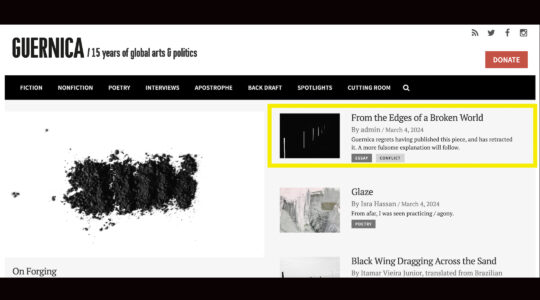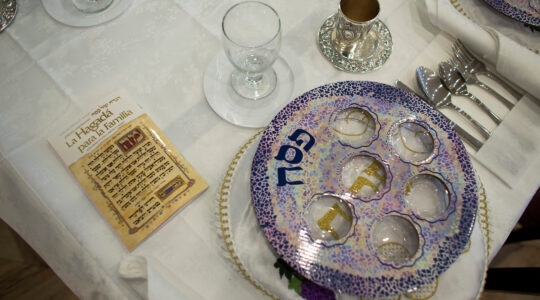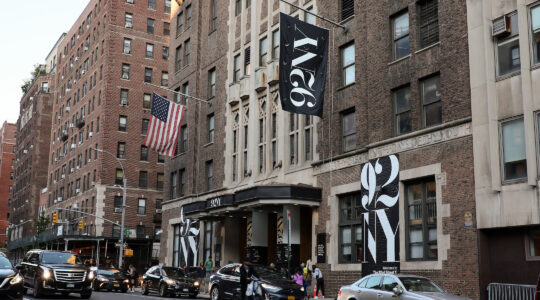NEW YORK (JTA) — “Why do we do this? Why do we tell this story every single year and not remember it, so we have to tell it the next year and the next year and the next year?” asks filmmaker Raphael Ward, staring into a camera in what looks like a YouTube vlog (video blog) entry.
“The reason is, through all of these stories — from the Four Questions, to everything, the crossing of the Red Sea — these stories are meant to inspire us and to allow us to take part in the story,” he says.
In fact, Ward’s monologue isn’t a vlog post but rather a short film meant to be his interpretation of the Maggid, the part of the Passover Haggadah that literally involves telling the story of the Exodus from Egypt.
Ward produced the film as part of “Projecting Freedom: Cinematic Interpretations of the Haggadah,” a project that aims to give a new take on the centuries-old book that lays down the order and liturgy of the seder.
The project, organized by the Skirball Center for Adult Jewish Learning at Temple Emanu-El in New York, brought together 11 filmmakers over the past year to study and produce five-minute films on each of the 14 sections of the Haggadah. It is the offspring of the Artists’ and Writers’ Beit Midrash, an 8-year-old Skirball program that brings together artists to learn Jewish texts so that they can reinterpret them through their own media. In this case, the study sessons were led by the center’s director, Rabbi Leon Morris.
“We have been working with visual artists and writers, and had seen the powerful effect of having creative individuals studying texts and create new artistic study on that text,” Morris said. “We decided to do the Haggadah because in some sense it is the most familiar text we have, but inevitably we wanted to show how unfamiliar it is.”
The films include an impressionistic take on Urchatz, the washing of the hands without saying a blessing, as well as an animated conversation between a young man and his grandfather about why the Jews eat bitter herbs as part of the seder.
Some of the films, like the one dealing with Rachtzah, the pre-meal washing of the hands with a blessing, and Nirtzah, the seder’s conclusion, were metaphoric.
Ilana Trachtman and Zelda Greenstein collaborated on those two films, which both explore a couple’s bout with infertility. Trachtman and Greenstein explained the ritual washing of the hands at the seder through the image of an ob-gyn washing his hands before performing a Caesarean section.
For Trachtman, the symbol made sense. Many of her friends, in their early 40s, were dealing with fertility issues when she and Greenstein launched their project. And the seder, she said, is all about preserving life.
“In the Haggadah you wash your hands. What are the reasons we wash? What are times in our lives when washing is elevated?” Trachtman said, explaining the thinking behind the film. “Doctors washing, surgery, then life and death was kind of easy. I think if [fertility issues] hadn’t been present in my mind, we might not have gotten there, but we certainly did not start with the idea of giving birth.”
Morris said that the hope was that each of the artists, of various ages and religious backgrounds, would bring a part of themselves to the project.
“I think they all took their piece of the Haggadah and ran with it,” he said. “They allowed it to show their experiences and their own ideas. And there is some kind of synthesis going on between each part of the Haggadah and the real life of the artist.”
A $40,000 grant from the Covenant Foundation, which gave each artist $1,000 to create their film, paid for the project.
Skirball is in discussions to expand the project to other cities. Morris said the idea ultimately is to produce several cinematic takes on each part of the Haggadah and then create a curriculum around them to help teach the seder.
Of course, the wider educational goals mean the films must rate closer to PG-13 than the R-rated first take of Carrie Dashow’s Korech, the making of the sandwich of bitter herbs and charoset. Dashow initially filmed a dozen people running nude on a snow-covered golf course and squirting each other with mustard and ketchup. The video was not included, but Dashow’s second take is interesting as well.
In the end, the idea was to provide the filmmakers an opportunity to offer their take because as Ward says in his film, the Haggadah “gives everyone a chance to speak.
“It gives enough material for everyone a chance to speak,” he said. “You’re supposed to pass along the story, and I don’t know about you guys, but it is my story, too.”
The films can be viewed at www.projectingfreedom.org.





